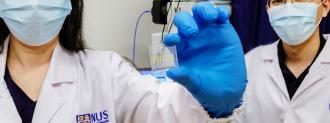A new blood test developed at the National University of Singapore (NUS) can determine whether a targeted cancer therapy is working within 24 hours of administration — giving doctors almost instant feedback on treatment.
The challenge: Targeted cancer therapies are drugs designed to interfere with specific molecules that help cancers grow or spread, and there are two ways for doctors to tell if they’re working, neither of which is ideal.
One option is to look at tissue samples, which must be collected through invasive biopsies. The other is to look at images of tumors, but it takes time for any treatment to be visible on x-rays or MRIs.
“Conventional procedures such as tumor imaging are not only expensive but also delayed,” lead scientist Shao Huilin said in a press release. “For these methods, treatment effectiveness can only be determined after weeks.”
This is a problem because the longer it takes to find an effective therapy, the lower a cancer patient’s chances of beating the disease.
A third option: If a targeted therapy successfully attaches to cancer cells, the cells will release particles that contain the drug, called extracellular vesicles (EVs), into the bloodstream.
That makes EVs a promising marker of treatment efficacy, but the particles are incredibly small — a hundred of them could fit across the width of a human hair — and they can’t be seen with traditional light microscopy.
ExoSCOPE: Now, NUS has developed a technique, called ExoSCOPE, that makes it possible to determine if a targeted cancer therapy is working within a day of its administration.
“The ExoSCOPE sensor contains millions of gold nanorings to capture the EVs and amplify their drug labelling signals to induce strong light signals,” co-first author Zhang Yan said. “These light signals are then processed to give a readout to indicate drug effectiveness.”
“This method requires only a tiny amount of blood sample for the analysis, and each test takes less than one hour to complete,” Shao added.
The trial: ExoSCOPE’s accuracy was tested in a trial involving 163 blood samples from more than 100 lung cancer patients.
Compared to the results of tumor imaging, it was 95% accurate at determining whether a targeted cancer therapy was effective — but while the imaging could only be done at the end of the treatment regimen, the ExoSCOPE test was conducted within 24 hours of its start.
The next steps: The researchers are now working to expand the abilities of ExoSCOPE so that it can be used to monitor targeted therapies for a variety of cancers, as well as cardiovascular and neurological diseases linked to EVs.
The goal is to have it ready for market within three years.
“I hope our technology can contribute towards personalised treatment, to guide the selection, dosage and duration of different treatments, and improve treatment outcomes,” Shao said.
We’d love to hear from you! If you have a comment about this article or if you have a tip for a future Freethink story, please email us at [email protected].






